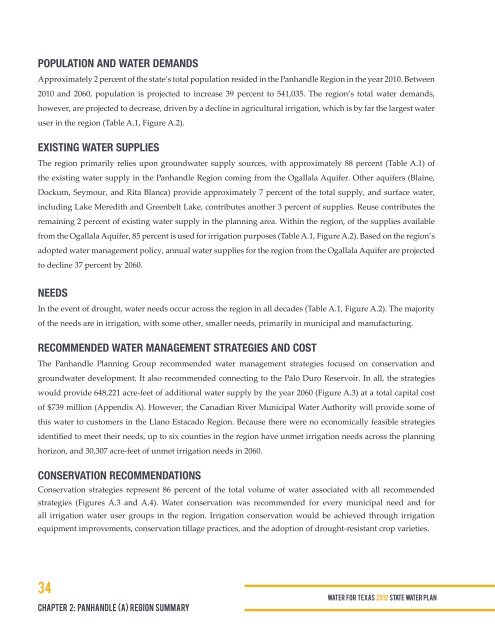Chapter 2 Regional Summaries - Texas Water Development Board
Chapter 2 Regional Summaries - Texas Water Development Board
Chapter 2 Regional Summaries - Texas Water Development Board
You also want an ePaper? Increase the reach of your titles
YUMPU automatically turns print PDFs into web optimized ePapers that Google loves.
POPULATION AND WATER DEMANDS<br />
Approximately 2 percent of the state’s total population resided in the Panhandle Region in the year 2010. Between<br />
2010 and 2060, population is projected to increase 39 percent to 541,035. The region’s total water demands,<br />
however, are projected to decrease, driven by a decline in agricultural irrigation, which is by far the largest water<br />
user in the region (Table A.1, Figure A.2).<br />
EXISTING WATER SUPPLIES<br />
The region primarily relies upon groundwater supply sources, with approximately 88 percent (Table A.1) of<br />
the existing water supply in the Panhandle Region coming from the Ogallala Aquifer. Other aquifers (Blaine,<br />
Dockum, Seymour, and Rita Blanca) provide approximately 7 percent of the total supply, and surface water,<br />
including Lake Meredith and Greenbelt Lake, contributes another 3 percent of supplies. Reuse contributes the<br />
remaining 2 percent of existing water supply in the planning area. Within the region, of the supplies available<br />
from the Ogallala Aquifer, 85 percent is used for irrigation purposes (Table A.1, Figure A.2). Based on the region’s<br />
adopted water management policy, annual water supplies for the region from the Ogallala Aquifer are projected<br />
to decline 37 percent by 2060.<br />
NEEDS<br />
In the event of drought, water needs occur across the region in all decades (Table A.1, Figure A.2). The majority<br />
of the needs are in irrigation, with some other, smaller needs, primarily in municipal and manufacturing.<br />
RECOMMENDED WATER MANAGEMENT STRATEGIES AND COST<br />
The Panhandle Planning Group recommended water management strategies focused on conservation and<br />
groundwater development. It also recommended connecting to the Palo Duro Reservoir. In all, the strategies<br />
would provide 648,221 acre-feet of additional water supply by the year 2060 (Figure A.3) at a total capital cost<br />
of $739 million (Appendix A). However, the Canadian River Municipal <strong>Water</strong> Authority will provide some of<br />
this water to customers in the Llano Estacado Region. Because there were no economically feasible strategies<br />
identified to meet their needs, up to six counties in the region have unmet irrigation needs across the planning<br />
horizon, and 30,307 acre-feet of unmet irrigation needs in 2060.<br />
CONSERVATION RECOMMENDATIONS<br />
Conservation strategies represent 86 percent of the total volume of water associated with all recommended<br />
strategies (Figures A.3 and A.4). <strong>Water</strong> conservation was recommended for every municipal need and for<br />
all irrigation water user groups in the region. Irrigation conservation would be achieved through irrigation<br />
equipment improvements, conservation tillage practices, and the adoption of drought-resistant crop varieties.<br />
34<br />
<strong>Chapter</strong> 2: Panhandle (A) region summary<br />
WAT E R FOR TEXAS 2012 STATE WATER PLAN
















